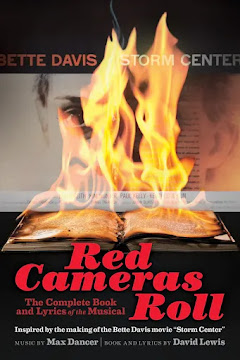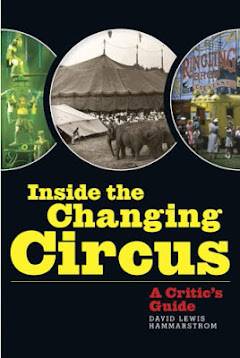
Take a look at the photo above. Grainy, yes — a still from a video I took, but this was the real thing. THE moment. THE reason we go to circuses.
Exotically charismatic young rolla bolla fellow, nameless per tradition, working over another rolla bolla, from tip of extended board flips cups and saucers onto his head. Called "bowl kicking," the display is set to music I would buy right now if I could, composed by one of China’s leading pop icons, Guo Feng. Possibly nothing better exemplifies the remarkable artistic revelations pouring down upon a new generation of Chinese Acrobats, long associated with preserving staid traditions, than this one crowing moment. Look what they’ve combined.
Point made already? Should I now take my leave?
Absolutely astonishing. Nothing can match the thrill for me of seeing for the first time something this good and so dramatically staged and scored.
Well, I’m too excited to take my leave, so here goes ...
You’ve likely seen a typical touring Chinese acrobatic troupe. On a stage. To recorded music. Scare scenery. Finely craft acts steeped in tradition from plate spinning to hoop diving.
After hundreds of years preserving strict traditions with impeccable fidelity, a modern Chinese style circus is now emerging. You’ve got to go there to see it. In Beijing. In Shanghai. In Guangzhou. In the major capitols, directors, choreographers and A-List song writers are crafting some brilliant shows. One even performs in a circle. And one even uses a live band. Another throws open the back doors to animal acts. All animals. Many of them feature a wheel of destiny and the motor bike globe of death. Better yet, some are inventing brand new aerial routines. Remember the Yunnan Flyers with Ringling in ‘06? They came from here, from one of the hundred or so acrobatic troupes that dot this mysteriously vast land.

“At the moment, we are in a very sensitive transitional period in time,” said Tian Run Min when we spoke at length over tea in the lobby of Hotel Kapok Wangfujing where I was staying, only a couple of blocks from the Forbidden City in Beijing. Mr. Tian graciously agreed to take my questions while a tape recorder ran. A most valuable source, he has been active in the acrobatic scene since 1985; he is a member of the China Acrobatic Artistes Association; he serves as artistic adviser to the Chinese State Circus in the U.K, for whom he supplies scholarly notes in its program magazines, and is a contributing editor to China Acrobatics & Magic. He also offers input to directors and choreographers and has co-scripted a few shows himself.
The subject of greatest interest to me were the surprisingly inventive shows I’d already seen during my visit. Great acts, I'd expected to see, yes. But shows? Mr. Tian acknowledged a creative ferment in the air. “There are very many influences with the Chinese acrobats,” he said. “from tradition to a new way. You can’t find an authority opinion.”
 A major point of discussion among leading Chinese directors concerns how much Cirque du Soleil influence should be allowed into the mix. “Some people say you can’t copy that. Some go to Cirque du Soleil and they try to learn everything. Other people say ‘doesn’t make sense, we should make something new and for yourself, and from China and from our traditions.’”
A major point of discussion among leading Chinese directors concerns how much Cirque du Soleil influence should be allowed into the mix. “Some people say you can’t copy that. Some go to Cirque du Soleil and they try to learn everything. Other people say ‘doesn’t make sense, we should make something new and for yourself, and from China and from our traditions.’”In fact, rare CDS visits to China have not fared anywhere near as well as they do in other markets.
Quite obliviously, the Cirque phenomenon has emboldened and/or challenged the countries world famous acrobats to think well beyond the act, into the realm of the entire show, and the results can be stunning. Nor are they slavishly imitative to my eyes. They are slyly adaptive. Think Bill Gates appropriating Steve Jobs.
Another force driving these dramatic changes are a slowly growing number of private as opposed to state funded troupes. The entrepreneurial spirit is on the rise here. Mr. Tian listed four companies, believing there may be several more. The government funds at least one troupe in each of the 22 provinces, sometimes two, and some city-based troupes as well. Yet no single agency in Beijing actively controls any of the troupes. Neither does the powerless Chinese Acrobatics Association. Explained Mr. Tian, there are only expectations from on high. “The government is officially saying you should present more shows for the people. You should make the new acts. You should train the talents, you should win more medals.”

 Go to Shanghai, and you’ll see over two nights the stark differences between a stolidly traditional troupe in a recital-like format so threadbare and stale you can almost smell the mildew. That would be the Charming Shanghai Acrobatic Show, above, at a very old and fraying theatre; the other would be the ultra contemporary ERA Intersection of Time, presented on a three-quarter round circular stage. With outside direction and scoring from Canadians (among them, long-time CDS choreographer Debra Brown), this high-tech ERA production builds masterfully on Chinese staples, linking them with live mood music, body movement interludes and a central recurring character in the form of an astonishingly gifted aging bowl balancer, another of the nameless wonders from a country that still can’t bring itself to name names. Somehow for me, though not for my friend Boyi Yuan (who preferred Charming Shanghai), ERA sustained itself in a mystical abstract realm. And somehow, eight motorcyclists inside the globe of death for a finale — an apt metaphor for this show’s name? — proved not tacky but almost hypnotic.
Go to Shanghai, and you’ll see over two nights the stark differences between a stolidly traditional troupe in a recital-like format so threadbare and stale you can almost smell the mildew. That would be the Charming Shanghai Acrobatic Show, above, at a very old and fraying theatre; the other would be the ultra contemporary ERA Intersection of Time, presented on a three-quarter round circular stage. With outside direction and scoring from Canadians (among them, long-time CDS choreographer Debra Brown), this high-tech ERA production builds masterfully on Chinese staples, linking them with live mood music, body movement interludes and a central recurring character in the form of an astonishingly gifted aging bowl balancer, another of the nameless wonders from a country that still can’t bring itself to name names. Somehow for me, though not for my friend Boyi Yuan (who preferred Charming Shanghai), ERA sustained itself in a mystical abstract realm. And somehow, eight motorcyclists inside the globe of death for a finale — an apt metaphor for this show’s name? — proved not tacky but almost hypnotic.
An even better ticket, on which both Boyi and I agreed, was the Flying Acrobatics Show in Beijing at the Chaoyang Theater, created and directed exclusively by Chinese, and another private venture if my notes are correct. They perform everyday at 5:15 and 7:15. The one hour and fifteen minute program, including a brief intermission, is terrifically paced and casts a powerful Chinese spell, achieved through Guo Feng’s original score and fantastic laser lighting effects. Thick makeup masks worn by the cast do not much please Mr. Tian, who views them as something of a sell out to Cirque showmanship.

Think what he may, thanks, I’d say, to the Montreal monster, at last the Chinese have found artistic liberation that one could argue they have long needed, a liberation they never got from watching U.S. shows. But still, I was curious and so I couldn’t help but ask Mr. Tian, “What do you think the Chinese directors in general think of the American circus?”
“We appreciate American circus use of production,” he replied. “The first, their production; The second is American circus use of the clown, very famous. Very impressive. Also, the presentation of the American circus artists.” My sharing guest surprised me with a personal definition of circus bordering on passionate advocacy:
“For me, the concept of circus: there are three: animals, clowns and the big top. there must be animals, also, it must be performed under the big top.”

Why the recent introduction of aerial acts into some programs? In fact, Mr. Tian told me there have been trapeze displays in years gone by, that some troupes performed under a tent, and a few of them featured animals.
I talked up the bowl kicking routine, and vented my frustration over discovering an outstanding artist whose name I could not find in the program. Why do they refuse to build up anybody’s personal identity, I wanted to scream. No, David, take another sip of tea.
“They don’t,” answered Mr. Tian ruefully, seeming to share my implicit aggravation. “No. They pay much attention to the whole group. They don’t like to train the single act. They don’t build up just one or two artists to become more famous.”
Is that a policy?
“I can’t understand,” he said. “For the other disciplines of the performing arts, like the Peking Opera, that’s the tradition. They build up the name.”
The directors, he suspects, are the culprits. “I am the boss. I must be more important than the artist.”
Another prime motivator for these impressive artistic developments can be directly attributed, Mr. Tian asserts, to “the international market and the international circus festivals, especially Monte Carlo and Salon Mondial du Cirque in Paris”
By far the most un-Chinese circus in China that I have glimpsed, only in YouTube clips, is the Chimelong Circus in Guangzhou, which also hosts foreign companies, among them visits by Russian performers. Its spectacular scenic and lighting effects give off a phantasmagorical atmosphere. Here there are many animal acts. I’m not sure what to make of it, having missed it during my recent trip.
I’ll end with the program photo of the bowl kicker. I like to play the movie I made of this feat, not just for the action but for the music. Somebody in the states should hire its composer Guo Feng to create an entire new circus score — if Guy Laliberte does not get to him first.
Want to see the future? Want to hear the future? Go to China.

[Photos, from the top: bowl kicker, figures at finale, contortionists from Flying Acrobatics Show; man pulling cart, vase juggler, aerial duo from ERA Intersection of Time; hat jugglers from Charming Shanghai Acrobatic Show.]
5.27.10






















2 comments:
David,
More great photos of China's circuses.
And I agree with you as circus to me is performance, animals, and the big top. Anything else is not circus to me.
I never have seen a rola bloa like that one, WOW very impressive.
Well the world is changing and it looks like China is right up there with it.
How was the attendance at the shows you attended and what prices do they charge.
Do they get $6 for popcorn, $10, for cotton candy and snow comes in a decorative cup, or $14 for a program.
Harry in Texas
Hi Harry,
Attendance, generally, and I did not take much time to scan the seats, was fair to moderate. I vaguely recall, maybe almost full house at ERA, half-plus houses at the other two venues. Tix prices not bad, but neither cheap, ranging from $13, rare, $25, doable, to $113 high.
Concessions? Good question, I haven't an answer! We did not patronize. I doubt the prices are very high, as very good meals in China are very reasonable. Seems the program magazines, lushly illustrated, were only a few dollars.
The rolla bolla was worth the price of admission alone!
Post a Comment